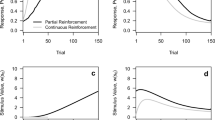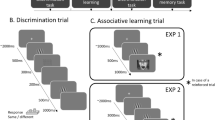Abstract
The experiment reviewed here was an attempt to show that two differential Pavlovian conditioning designs, namely positive and negative patterning, can best be understood as rule learning. First, it is shown that positive patterning is equivalent to the logical rule of conjunction (AND) and that negative patterning is equivalent to the logical rule of exclusive disjunction (XOR). It is assumed that in order to learn both kinds of discrimination subjects learn to use the according rule. If this is the case, the observed differentiation should be independent of the number of reinforcements for each individual stimulus. Second, subjects should be able to transfer the rule to new stimuli. Forty human subjects were randomly divided into four groups (N=10 each). Two factors were manipulated independently between subjects: (1) positive vs negative patterning, and (2) 2 vs 4 pairs of trained stimuli. Second interval skin conductance responses were measured. During initial acquisition positive as well as negative patterning occurred independently of number of pairs of trained stimuli (with total amount of training kept constant). Furthermore, AND as well as XOR could be transfered to new stimuli.
Similar content being viewed by others
References
Bellingham, W.P., Gillette-Bellingham, K., & Kehoe, E.J. (1985). Summation and configuration in patterning schedules with the rat and rabbit.Animal Learning & Behavior, 13, 152–164.
Greenhouse, S.W., & Geisser, S. (1959). On methods in the analysis of profile data.Psychometrika, 24, 95–112.
Haygood, R.C., & Bourne, L.E. (1965). Attribute- and rule-learning aspects of conceptual behavior.Psychological Review, 72, 175–195.
Kimmel, H.D., & Lachnit, H. (1991). Acquisition of a unique cue in positive and negative patterning?Integrative Physiological and Behavioral Science, 26, 32–38.
Lachnit, H. (1992). Pavlovian conditioning and cognitive psychology: The case of inductive reasoning.The German Journal of Psychology, 16, 273–282.
Mackintosh, A.B. (1975). A theory of attention: Variations in the associability of stimuli with reinforcement.Psychological Review, 82, 276–298.
Pearce, J.M., & Hall, G. (1980). A model for Pavlovian learning: Variations in the effectiveness of conditioned but not of unconditioned stimuli.Psychological Review, 87, 532–552.
Rescorla, R.A., & Wagner, A.R. (1972). A theory of Pavlovian conditioning: Variations in the effectiveness of reinforcement and nonreinforcement. In A.H. Black & W.F. Prokasy (Eds.),Classical conditioning II (pp. 64–99). New York: Appleton-Century-Crofts.
Whitlow, J.W., Jr., & Wagner, A.R. (1972). Negative patterning in classical conditioning: Summation of response tendencies to isolable and configural components.Psychonomic Science, 27, 299–301.
Author information
Authors and Affiliations
Corresponding author
Rights and permissions
About this article
Cite this article
Kleinschmidt, H., Lachnit, H. Pavlovian conditioning and rule learning. Integrative Physiological and Behavioral Science 28, 158–162 (1993). https://doi.org/10.1007/BF02691220
Issue Date:
DOI: https://doi.org/10.1007/BF02691220




